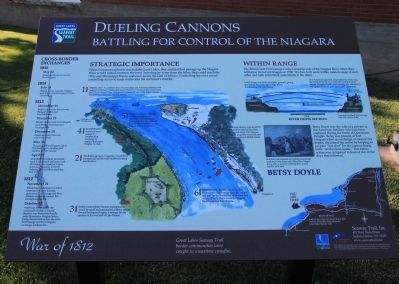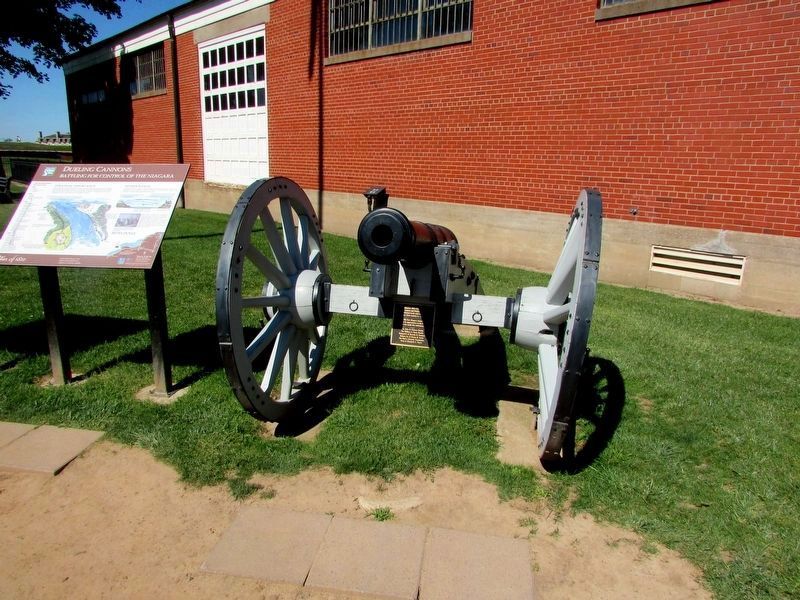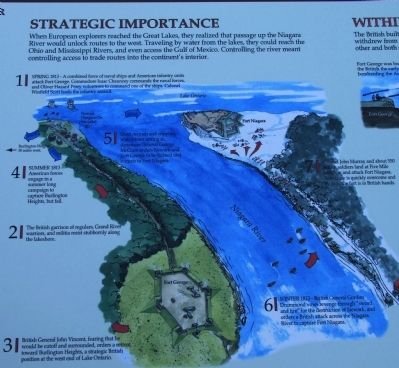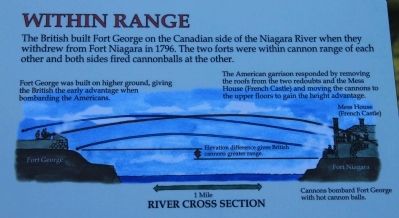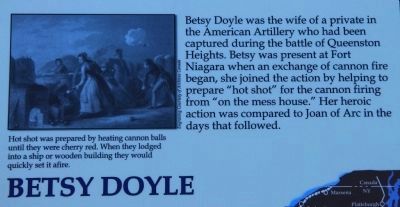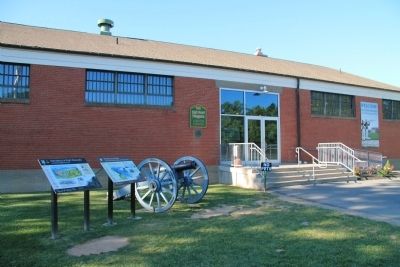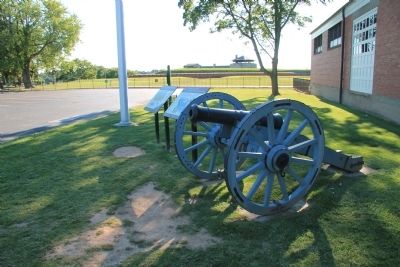Youngstown in Niagara County, New York — The American Northeast (Mid-Atlantic)
Dueling Cannons
Battling for Control of the Niagara
When European explorers reached the Great Lakes, they realized that passage up the Niagara River would unlock routes to the west. Traveling by water from the lakes, they could reach the Ohio and Mississippi Rivers, and even access the Gulf of Mexico. Controlling the river meant controlling access to trade routes into the continent's interior.
1. Spring 1813 - A combined force of naval ships and American infantry units attack Fort George. Commodore Isaac Chauncey commands the naval forces, and Oliver Hazard Perry volunteers to command one of the ships. Colonel Winfield Scott leads the infantry assault.
2. The British garrison of regulars, Grand River warriors, and militia resist stubbornly along the lakeshore.
3. British General John Vincent, fearing that he would be cutoff and surrounded, orders a retreat toward Burlington Heights, a strategic British position at the west end of Lake Ontario.
4. Summer 1813 - American forces engage in a summer long campaign to capture Burlington Heights, but fail.
5. Short on men and supplies, with winter setting in, American General George McClure orders Newark and Fort George to be burned and retreats to Fort Niagara.
6. Winter 1813 - British General Gordon Drummond vows revenge through "sword and fire" for the destruction of Newark, and orders a British attack across the Niagara River to capture Fort Niagara.
7. Colonel John Murray and about 550 British soldiers land at Five Mile Meadow and attack Fort Niagara. Resistance is quickly overcome and by 5am, the fort is in British hands.
Within Range
The British built Fort George on the Canadian side of the Niagara River when they withdrew from Fort Niagara in 1796. The two forts were within cannon range of each other and both sides fired cannonballs at the other.
Fort George was built on higher ground, giving the British the early advantage when bombarding the Americans.
The American garrison responded by removing the roofs from the two redoubts and the Mess House (French Castle) and moving the cannons to the upper floors to gain the height advantage.
Betsy Doyle
Betsy Doyle was the wife of a private in the American Artillery who had been captured during the battle of Queenston Heights. Betsy was present at Fort Niagara when an exchange of cannon fire began, she joined the action by helping to prepare "hot shot" for the cannon firing from "on the mess house." Her heroic action was compared to Joan of Arc in the days that followed.
Hot shot was prepared by heating cannon balls until they were cherry red. When they lodged into a ship or wooden building they would quickly set it afire.
Cross-Border Exchanges
1812
October 13
American forces under the command of Major General Stephen van Rensselaer briefly seize Queenston Heights before being driven back across the river. Fort George and Fort Niagara exchange artillery fire.
November 21
Following the American's failed invasion of Upper Canada, gunners at Fort George and Fort Niagara exchange cannon fire throughout the day,
1813
April 27
Combined American naval and land forces attack and burn York (Toronto), the capital of Upper Canada. American General Zebulon Pike is killed attacking Fort York.
May 26
The guns at Fort Niagara aid in Winfield Scott's landing and capture of Fort George.
December 10
Americans burn Newark and Fort George.
December 19
British attacks seize Fort Niagara and destroy Lewiston and Youngstown.
December 21
British raids burn Manchester (Niagara Falls) and Fort Schlosser.
1814
July 24
British forces cross the Niagara and drive American
guards from Lewiston.
1815
May 22
American troops re-occupy Fort Niagara.
Erected by Seaway Trail, Inc.
Topics. This historical marker is listed in these topic lists: Forts and Castles • War of 1812. A significant historical month for this entry is April 1766.
Location. 43° 15.747′ N, 79° 3.632′ W. Marker is in Youngstown, New York, in Niagara County. Marker is on Scott Avenue north of Jackson Street (Route 18F), on the right when traveling north. This historical marker is located a short drive north of the downtown Youngstown area, in the Fort Niagara State Park. According to Google Map it is located at the end of the Scott Avenue loop, next to the front entrance to the Visitor Center & Museum for Old Fort Niagara. Touch for map. Marker is in this post office area: Youngstown NY 14174, United States of America. Touch for directions.
Other nearby markers. At least 8 other markers are within walking distance of this marker. The Siege of Fort Niagara (here, next to this marker); Old Fort Niagara Cannon (here, next to this marker); Old Fort Niagara (a few steps from this marker); Morrow Plaza (a few steps from this marker); The Niagara Portage: Gateway to the West (within shouting distance of this marker); a different marker also named Old Fort Niagara (within shouting distance
of this marker); Old Fort Niagara Lighthouse (within shouting distance of this marker); To the Memory (about 400 feet away, measured in a direct line). Touch for a list and map of all markers in Youngstown.
Credits. This page was last revised on September 24, 2019. It was originally submitted on August 10, 2013, by Dale K. Benington of Toledo, Ohio. This page has been viewed 892 times since then and 36 times this year. Photos: 1. submitted on August 10, 2013, by Dale K. Benington of Toledo, Ohio. 2. submitted on September 23, 2019, by Bill Coughlin of Woodland Park, New Jersey. 3, 4, 5, 6, 7, 8. submitted on August 10, 2013, by Dale K. Benington of Toledo, Ohio.
